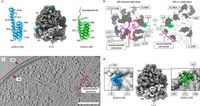Researchers have uncovered intriguing details about ribosome heterogeneity in bacterial cells, providing new perspectives on how these essential structures function. Using advanced cryo-electron microscopy techniques and tomography, a team of scientists studied the ribosomes from the cold-adapted bacterium Psychrobacter urativorans. Their findings reveal that a significant 70% of these ribosomes sport an additional copy of the ribosomal protein bS20, found at a previously unknown site on the large ribosomal subunit. Interestingly, this second copy of bS20 appears to play a functionally neutral role, challenging earlier notions that structural variations in ribosomes might correlate with specialized functions in protein synthesis.<\/p>
This research not only addresses misconceptions about ribosome functioning but also indicates that these heterogeneous ribosomes are capable of cooperative behavior during protein synthesis, rather than segregating into specialized roles. The concept of ribosome heterogeneity has long intrigued biologists, positing that structurally distinct ribosomes might be utilized for diverse mRNA translations. While many studies lent credence to this theory, recent findings suggest that such variations might instead arise from stochastic processes in ribosome assembly, further muddying the waters of ribosomal function.<\/p>
Over the decades, scientists have championed interacting ribosomal proteins and the structural dynamics of ribosomes as key players in cellular processes. The notion that ribosome structure could inform mRNA specificity and translation efficiency was particularly appealing. However, the research led by Helena-Bueno, K. and her team sheds light on a potential reinterpretation of ribosome roles within cells. They utilize cryo-electron tomography to visualize these ribosomes under their natural conditions, revealing that the presence of additional ribosomal proteins, like bS20, does not lead to any observable functional specialization.
Using this technique, known for its precision in observing cellular structures, the researchers identified that an additional bS20 protein, earlier thought to be merely an artifact of isolation, is indeed present binding to the large subunit of ribosomes within living bacterial cells. The study elaborates on the molecular dynamics of these ribosomes, discovering that while 100% of the small subunits carry bS20, only around 67% of large subunits do, indicating a substoichiometric presence across different ribosomal types.
To gauge the functional implications of this heterogeneity, the scientists analyzed ribosomal behaviors in situ, observing translation dynamics within the cytoplasm of P. urativorans. Their results showed that both ribosomal populations, 1xbS20 and 2xbS20, exhibited the same distribution of functional states throughout the translation process, such as tRNA binding and elongation. This uniform behavior indicates that the presence of the second bS20 does not influence how ribosomes associate with other translation factors, such as Trigger Factor, a protein involved in co-translational protein folding.
Further analysis suggested that these structurally heterogeneous ribosomes coexist within polysomes, forming complexes that effectively translate the same mRNA molecules. The average proportion of ribosomes with the second bS20 was about 67%, indicating that these types of ribosomes dynamically work together, significantly contributing to efficient protein synthesis processes.
The findings also bring into focus the question of how ribosome composition can exhibit variation while still performing an equivalent function. The researchers found a disparity in the number of molecular interactions between bS20 and the ribosomal subunits; bS20 binds relatively more strongly to the small subunit, compared to the large one, indicating that the necessity for bS20 in the large subunit might not be as vital. This preference hints at a fine balance in how ribosomal architecture is conserved across different species, particularly among proteobacteria.
The implications of this research ripple through the field of molecular biology, suggesting a pathway towards understanding ribosome functionality through a new lens. It prompts scientists to reevaluate entrenched beliefs about the significant correlation between structural diversity and functional specialization in ribosomes. This advance counteracts over fifty years of assumptions and reinforces the idea that ribosomes can maintain cooperative behaviors regardless of structural heterogeneity. With the launch of new studies that delve deeper into this phenomenon, the scientific community may uncover additional layers of complexity surrounding ribosomal dynamics and their influence on cellular processes.
In summary, this study articulates that heterogeneous ribosomes within P. urativorans coexist and function collaboratively, revealing that structural variation does not necessitate varied functional roles. As ribosome research evolves and employs ever-more sophisticated observation methods, the understanding of these cellular powerhouses continues to develop, paving the way for future discoveries in bacterial biology and beyond.




